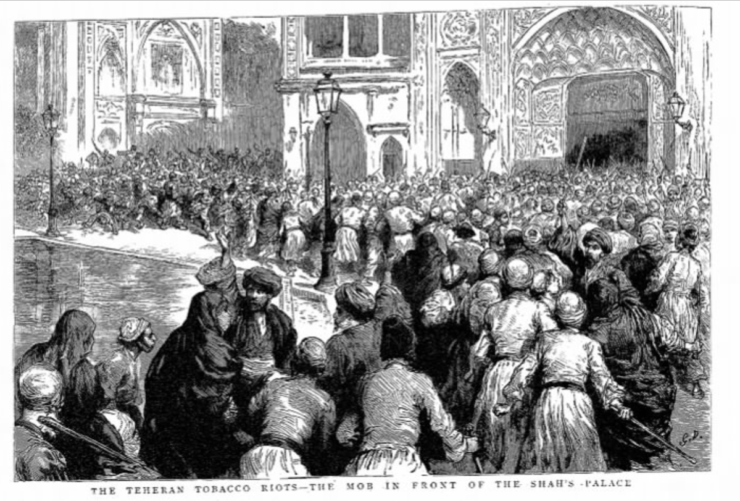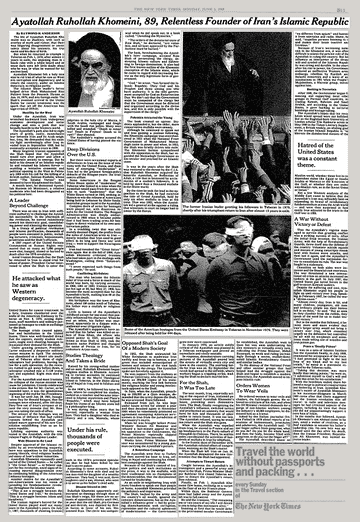The Facial Crisis of Shiite Iran
Arash Jazi
The theocratic regime of Iran has been facing inflating crises of legitimacy and power for the past two decades. The regime’s brutality, its destabilizing military activities in the region, its thievery economic policies and its never-ending creativity to make new forms of terror have led to a rising public aversion against religion in Iran. The Coronacrisis has especially made these resentments and mistrusts manifest, more so on the social media, where strong reactions against religious attitudes were widely expressed (see the blogpost by Pooyan Tamimi Arab): the mockery of Khamenei’s reference to a Quranic verse in which demonic enemies were blamed for the epidemic, the derision of a certain therapeutic technique prescribed by a prominent mulla-physician, and the reactions to a pious man’s shrine-licking are among the most popular examples. These reactions echo a much older discourse that dates back to the nineteenth-century cholera pandemics that always included Iran among the severely hit places. One difference, however, is that back then cholera epidemics emerged in a media ecology that favored the Shiite clerics while in the present, the Coronavirus has been mostly broadcasted on the digital media and is not so much in favor of the clerics. Both media and religion evolved in complex ways from cholera to Covid-19 pandemics. Understanding this co-evolution can put the present crisis of the Iranian religious regime in perspective. How did the nineteenth-century cholera pandemics affect the clerical power and how is that power currently coping with the present Coronacrisis? In this text, I present a crude sketch to respond to this question.
Back in the nineteenth century when the first polytechnic institute, the Dar al-Funun (1851), was established in Tehran, print, telegraphy and photography posed serious challenges to the old ways of communication and knowledge-making in the Shiite clerical culture. Although at first the clergy resisted these new innovations, later on, having realized the advantages of using those technologies, many clergies assimilated them into their own practices. By the time Khomeini consolidated the clerical power in the 1980s, almost all the media technologies, from print and photography to radio and television, had become part and parcel of clerical practices. Up until now, we could therefore say that the modern Shiism, through adapting to the new media ecologies, has already assimilated several strands of Western sciences into its own epistemic organization. A definitive moment in this long history of media assimilation took place in the final decade of that century.
Amir Afkhami, in his book A Modern Contagion, implicitly draws attention to this moment, pin pointed to the year 1892. The then monarch, Nasir al-Din Shah, was developing stronger ties with the British government. In a move to get closer to the latter, the Persian king bestowed full commercial monopoly over tobacco crops to a British merchant. This decision outraged the local merchants, who joined forces for the first time with the clerics. The result was the issue of a fatwa against the tobacco consumption by the Grand Ayatollah Mirza Hassan Shirazi (2019: 52). The fatwa was widely circulated around the nation using the telegraphic network sponsored and managed by the British. Moreover, this episode took place during the most brutal epidemic of cholera in the century, the outbreak of 1889. Concurrent with the State failure to manage the epidemic, the concession over tobacco commerce acted as a catalyzer and ignited a nationwide protest against the government.
A snapshot of this protest was taken on January 4th, 1892, by an anonymous eye-witness in the form of a drawing. The sketch was published in a weekly newspaper in England, The Graphic in February the same year. Afkhami reproduces this image in his book, which shows a large crowd quite visibly led by a few clergymen at the entrance to the royal palace in Tehran (Fig. 1). While the ordinary people in the mass have their backs to the viewer, the clergymen are facing the opposite direction, toward the viewer. Their right hands are all raised up and their faces are drawn with much more detail than the few visible profiles of the ordinary protesters. This was a formative moment for the clerical order as it was the first time that the clerics successfully steered the mass toward a clear goal in one unified protest. Never before have the clerics been that close to the public, having the power to incite and mobilize them en masse. In fact, they have never been sociopolitically powerful. Politically, they were surely powerful at least from the 14th century to the 16th century during the highly religious Safavid reign. In the chaotic period after the fall of Safavid until the early Qajar period in the late 18th century, they had some social power, while their political sway over the emerging nation-state was rather meagre (Algar 1980; Arjomand 1984; Matthee 2011). But only when they managed to re-appropriate and tap into the emerging media ecology of the globalization period from the early nineteenth century onward, could they finally form a macro-scale sociopolitical identity. It was no coincidence that the sketch artist payed attention to the mullas’ faces. For that Western observer, they were evidently the Face of the crowd.

Fig. 1. Tobacco protesters in front of the royal palace in Tehran, 1892. Source: The Graphic.
Those faces were not necessarily personal, in that they were not representative of a certain individual. They were the Face of the people, not merely individual faces among them. The mulla-figure was the Face: turban on the top and beard at the bottom. They were not faces of a person’s body, but the Face of the mass. Deleuze and Guattari write in A Thousand Plateaus that “the face is a map, even when it is applied to and wraps a volume … The head, even the human head, is not necessarily a face. The face is produced only when the head ceases to be a part of the body, when it ceases to be coded by the body … when the body, head included, has been decoded and has to be overcoded by something we shall call the Face” (1987: 170). In this sense, the mulla-figure became precisely the Face of people by wrapping around the body of the mass, a map that guided and coded the crowd as well as the Western observer’s gaze.
Below that sketch published in The Graphic that year, which Afkhami does not include in his work, was another image irrelevant to the content in the first (Fig. 2), though not entirely random. The caption reads “The wreck of the Eider—the salvage corps at work”. The drawing pertained to a historical shipwreck in which one of the famous British ships, SS Eider, sank in the English channel in January of the same year. The choice of putting these two images together could not have been a random choice. The English navy was the globalizing vanguard in the nineteenth century. The ships were the most fundamental and indispensable medium of colonization. A shipwreck was therefore not just a human tragedy but a calamity that slowed down the colonial machinery of the Victorian era. In this context, the Iranian Tobacco protest was a blow against that machinery, a loss of face by the Western power. More significantly for the Iranian clerics, those ships were the prime suspects for bringing cholera and the plague into Iran. The juxtaposition of those two images gestured towards a historical moment in which the clergy was finding a face while the West was losing one—perhaps the lack of facial details in that second sketch was not just a random choice either.

Fig. 2. Sketch of the marine corps on the SS Eider. Source: The Graphic.
This drawing was not the only visual representation of the clergy in Western media. In the midst of the constitutional movement in the 1900s, the clerics were already much too visible to the Western eye. Far more popular than a few decades before, they were seen as the representatives of the Iranian society. Their role did not escape the journalists’ attention at the time, which we find in abundance in the newspapers and periodicals published in England and the US. For instance, in an issue of The Times on December 3, 1907, we read a column written by a Western correspondent on the newly formed Parliament that “the clergy still retained a sufficient hold over them [people] to work them up at any moment to a dangerous pitch of excitement”. The reporter continued with a visual description of the Parliament by noting that “[t]he Turbans of the Mollahs fill three quarter of the house [of the Parliament]”, a visual spectacle that suggests how the turban-figure was already viewed as the Face of the mass in Western observers’ view. Fast-forwarding to the 1980s, we get a more contemporary example in a The New York Times issue on June 5, 1989. There, on the article front page titled “Ayatollah Ruhollah Khomeini, Relentless Founder of Iran’s Islamic Republic” we see Khomeini magnanimously facing a crowd whose hands are longing for him (Fig. 3). Below, we see another image, which shows a few hostages taken during the American embassy occupation between 1979-1981: on the top we see the facialization of the Iranian clerics, this time with Khomeini, while at the bottom the losing-face of the West—clearly manifest in the blindfolded hostages’ (non-)faces.

Fig. 3. An article published on The New York Times, 1989. Source: The New York Times.
These examples hinted at the rising power of the clergy on the global scene. That the clerics desired power and evolved advanced enough to be facialized did not put them in opposition to the moderns. The binary of tradition-modernity, although quite real at the time, was only one aspect of the much more complex and non-binary cultural transformation. There are strong evidences that suggests the clerics welcomed and assimilated all the new sciences and learned to use and appropriate most of the emerging media technologies. Along these adaptations, new political vocabulary annexed to the clerical jargons, such as “republic”, “elections”, referendum” and “class”. The Face of the revolution, Khomeini, was then the most evolved version of this century-long facializing Shiite machine (you can still find the face of Khomeini sprayed on walls and electric posts in Iranian cities, a highly abstracted figure that highlights the turban and the beard more than any other personal features of Khomeini’s face. This very abstracted figure was even seen by many on the moon).
In contradistinction to its facializing period in the past, the Islamic regime is losing face today. When the news of the first confirmed cases of Covid-19 in the holy city of Qum broke out, the religious authorities could not, as comfortably as before, implement the clinical restrictions such as quarantine. The assimilated sciences felt like an uneasy fit to the clerical thought. How could this horrible biological disaster befall the city of Qum, the most sacred and the holiest place in Iran, the centre of Shia scholarship and the backbone of Islamic Revolution? The State was hysterical. This simple fact was already quite unsettling for a regime facing a much too protracted crisis of legitimacy and power. It was as if some occult supernatural cause had punished the Islamic Republic for its vices. Consequently, the Islamic state was adamant to impose quarantine on the city. The religiosity of Qum seemed to have had been undermined if the city would have been quarantined. Confused and clueless, the State could make no sensible decision. A swarm of special task force units were dispatched to the city, with no apparent mission (see the video). This hysterical act was strangely similar to the regime’s reaction against the protests that took place three months ago against the rising prices of gas nationwide. The regime had shut down the internet and sent out its special units to the streets to oppress the riots.
By protest or pestilence, the regime has been under threats that have as their focal points the very religious core of the Islamic State. Losing face, the regime is hysterically spiraling out of its religious axis. If the cholera of the nineteenth century joined forces with the clerics in the face of the monarchic state, the Coronavirus is now working against the clerics, defacing their manic religious edifice. The facializing machine of Shiism in the present bio-media ecology has lost its ties to the clerical strata it had once been an integral part of. For the Islamic regime, the pressing question is whether or not it can reconstruct its faciality. The possibility is certainly there. The question is will the protests continue after the Coronacrisis is over or will they be dissolved? Will the protests join the Coronacrisis or will they stand behind the state and re-legitimize it with a new face?
Arash Jazi is a PhD candidate at the department of Philosophy and Religious Studies. He is currently working as part of the SENSIS project looking at the 19th century Iran. His main fields of interest are media history and religious studies.

References
Afkhami, Amir A. A Modern Contagion: Imperialism and Public Health in Iran’s Age of Cholera. JHU Press, 2019.
Algar, Hamid. Religion and state in Iran, 1785-1906: the role of the ulama in the Qajar period. No. 17. Univ of California Press, 1980.
Arjomand, Said Amir. The Shadow of God and the Hidden Imam: religion, political order, and societal change in Shi’ite Iran from the beginning to 1890. Chicago: University of Chicago Press, 1984.
Deleuze, Gilles, and Félix Guattari. A Thousand Plateaus: Capitalism and Schizophrenia. 1980. Trans. Brian Massumi. Minneapolis: U of Minnesota P, 1987.
Matthee, Rudi. Persia in crisis: Safavid decline and the fall of Isfahan. Bloomsbury Publishing, 2011.
Tamimi Arab, Pooyan. “On Secularization and the Coronavirus in Iran”, Religious Matters weblog, 2020. Link.
This blog is a part of ‘Dossier Corona’, introduced by Religious Matters in the spring of 2020.
